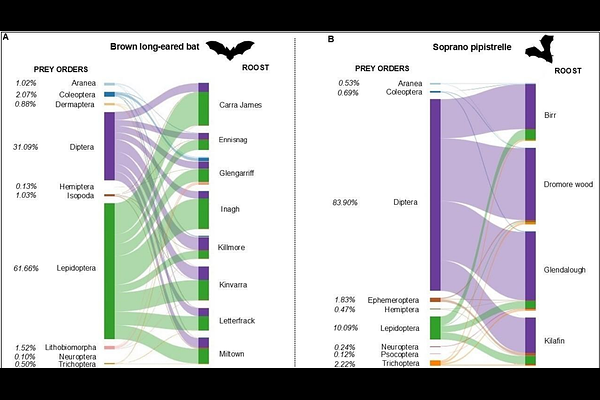Metabarcoding reveals the effect of land cover and temporal variations on the diet of Brown long-eared and Soprano pipistrelle bats within a unique European habitat, the pasture dominated landscapes of Ireland.

Metabarcoding reveals the effect of land cover and temporal variations on the diet of Brown long-eared and Soprano pipistrelle bats within a unique European habitat, the pasture dominated landscapes of Ireland.
Hurpy, G.; Aughney, T.; Skujina, I.; Roche, N.; Teeling, E. C.
AbstractConsidered as tertiary keystone predators, insectivorous bats play essential roles in maintaining the functioning of ecosystems. Investigating how bat species\' diets vary across landscapes is crucial for understanding bat ecology and their role in ecosystem health. Here, we characterised the predator-prey interactions of two common bat species with different foraging strategies, the Brown long-eared bat (Plecotus auritus) and Soprano pipistrelle (Pipistrellus pygmaeus), across the unique pastureland dominated landscape of Ireland. Over three years (2021-2023), faecal samples (n=4,627 in total) were collected annually at three time points (gestation, lactation, post-lactation) from twelve maternity roosts and analysed using metabarcoding and next-generation sequencing. Both bat species showed broad diet diversity, with 392 and 350 arthropod species identified for Brown long-eared bat and Soprano pipistrelle, respectively, primarily Lepidoptera and Diptera. The Brown long-eared bat exhibited a generalist diet demonstrating dietary flexibility. Lepidoptera interactions were more frequent overall (62%) compared to Diptera (31%), but interactions with Diptera species increased markedly at one specific roost, highlighting its capacity to adjust its diet to local prey availability. In contrast, the Soprano pipistrelle exhibited a more specialised diet, with 83% consisting of Diptera species. Both spatial and temporal factors significantly influenced dietary richness and composition in both species. Surrounding land cover, in particular, played an important role in shaping diet composition. Our findings suggest that the Brown long-eared bat exhibits a broad foraging strategy, acting as a generalist with a preference for Lepidoptera, while the Soprano pipistrelle shows a consistent reliance on Diptera. This study underscores the reliance of two widespread bat species, which play an important role in ecosystem well-being, on diverse insect taxa, highlighting the urgent need to conserve these insect populations.